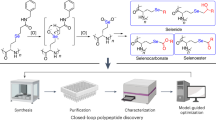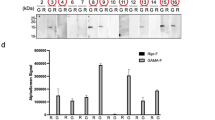Abstract
I describe a technique for screening peptide libraries of over 109 independent clones for substrates of peptide-modifying enzymes. The peptides, linked to their genetic material by the lac repressor, are exposed to the enzyme and then screened by affinity purification on a receptor specific for the modified product. The enzyme characterized, E. coli biotin holoenzyme synthetase, normally adds biotin to a specific lysine residue in complex protein domains. The 13 residue substrate identified by this library screening approach is much smaller than the 75 amino acid required sequence of the natural substrate, and can function at either end of a fusion protein. The sequence is quite distinct at some positions from that region of the natural substrates, presumably because the peptides have to mimic the folded structure formed by the natural substrate. This technique should be useful for mapping the substrate specificity of a variety of peptide-modifying enzymes. In addition, small peptide substrates that are enzymatically biotinylated at a single site should be useful for a variety of purposes in labeling, purification, detection, and immobilization of proteins.
This is a preview of subscription content, access via your institution
Access options
Subscribe to this journal
Receive 12 print issues and online access
$209.00 per year
only $17.42 per issue
Buy this article
- Purchase on Springer Link
- Instant access to full article PDF
Prices may be subject to local taxes which are calculated during checkout
Similar content being viewed by others
References
Cwirla, S.E., Peters, E.A., Barrett, R.W. and Dower, W.J. 1990. Peptides on phage: a vast library of peptides for identifying ligands. Proc. Natl. Acad. Sci. USA 87: 6378–6382.
Devlin, J.J., Panganiban, L.C. and Devlin, P.E. 1990. Random peptide libraries: a source of specific protein binding molecules. Science 249: 404–406.
Scott, J.K. and Smith, G.P. 1990. Searching for peptide ligands with an epitope library. Science 249: 386–390.
Marks, J.D., Hoogenboom, H.R., Griffiths, A.D. and Winter, G. 1992. Molecular evolution of proteins on filamentous phage. J. Biol. Chem. 267: 16007–16010.
Brown, S. 1992. Engineered iron oxide-adhesion mutants of the Escherichia coli phage lambda receptor. Proc. Natl. Acad. Sci. USA 89: 8651–8655.
Cull, M.G., Miller, J.F. and Schatz, P.J. 1992. Screening for receptor ligands using large libraries of peptides linked to the C terminus of the lac represser. Proc. Natl. Acad. Sci. USA 89: 1865–1869.
Matthews, D.J. and Wells, J.A. 1993. Substrate phage: selection of protease substrates by monovalent phage display. Science 260: 1113–1117.
Methods in Enzymology, vol. 184: Avidin-Biotin Technology. 1990. Wilchek, M. and Bayer, E. A. (Eds.). Academic Press. San Diego.
Bayer, E.A. and Wilchek, M. 1990. Protein biotinylation. Methods Enzymol. 184: 138–160.
Samols, D., Thornton, C.G., Murtif, V.L., Kumar, G.K., Haase, F.C. and Wood, H.G. 1988. Evolutionary conservation among biotin enzymes. J. Biol. Chem. 263: 6461–6464.
Chandler, C.S. and Ballard, F.J. 1988. Regulation of the breakdown rates of biotin-containing proteins in Swiss 3T3-L1 cells. Biochem. J. 251: 749–755.
Fall, R.R. 1979. Analysis of microbial biotin proteins. Methods Enzymol. 62: 390–398.
Robinson, B.H., Oei, J., Saunders, M. and Gravel, R. 1983. 3H-Biotin-labeled proteins in cultured human skin fibroblasts from patients with pyruvate car-boxylase deficiency. J. Biol. Chem. 258: 6660–6664.
Murtif, V.L. and Samols, D. 1987. Mutagenesis affecting the carboxyl terminus of the biotinyl subunit of transcarboxylase. J. Biol. Chem. 262: 11813–11816.
Reed, K.E. and Cronan, J.E., Jr. 1991. Escherichia coli exports previously folded and biotinated protein domains. J. Biol. Chem. 266: 11425–11428.
Shenoy, B.C., Paranjape, S., Murtif, V.L., Kumar, G.K., Samols, D. and Wood, H.G. 1988. Effect of mutations at Met-88 and Met-90 on the biotination of Lys-89 of the apo 1.3S subunit of transcarboxylase. FASEB J. 2: 2505–2511.
Cronan, J.E., Jr. 1990. Biotination of proteins in vivo. A post-translational modification to label, purify, and study proteins. J. Biol. Chem. 265: 10327–10333.
Yamano, N., Kawata, Y., Kojima, H., Yoda, K. and Yamasaki, M. 1992. In vivo biotinylation effusion proteins expressed in Escherichia coli with a sequence of Propionibacterium/reudenreichii transcarboxylase 1.3S biotin subunit. Biosci. Biotech. Biochem. 56: 1017–1026.
Barker, D.F. and Campbell, A.M. 1981 Genetic and biochemical characterization of the birA gene and its product: evidence for a direct role of biotin holoenzyme synthetase in repression of the biotin operon in Escherichia coli. J. Mol. Biol. 146: 469–492.
Barker, D.F. and Campbell, A.M. 1981. The bir A gene of Escherichia coli encodes a biotin holoenzyme synthetase. J. Mol. Biol. 146: 451–467.
Wilson, K.P., Shewchuk, L.M., Brennan, R.G., Otsuka, A.J. and Matthews, B.W. 1992. Escherichia coli biotin holoenzyme synthetase/bio represser crystal structure delineates the biotin- and DNA-binding domains. Proc. Natl. Acad. Sci. USA 89: 9257–9261.
Howard, P.K., Shaw, J. and Otsuka, A.J. 1985. Nucleotide sequence of the birA gene encoding the biotin represser and biotin holoenzyme synthetase functions of Escherichia coli. Gene 35: 321–331.
Cronan, J.E., Jr, 1989. The E. coli bio operon: transcriptional repression by an essential protein modification enzyme. Cell 58: 427–429.
Lam, K.S., Salmon, S.E., Hersh, E.M., Hruby, V.L., Kazmierski, W.M. and Knapp, R.J. 1991. A new type of synthetic peptide library for identifying ligand-binding activity. Nature 354: 82–84.
Green, N.M. 1990. Avidin and streptavidin. Methods Enzymol. 184: 51–67.
Shenoy, B.C., Xie, Y., Park, V.L., Kumar, G.K., Beegen, H., Wood, H.G. and Samols, D. 1992. The importance of methionine residues for the catalysis of the biotin enzyme, transcarboxylase. J. Biol. Chem. 267: 18407–18412.
Kondo, H., Uno, S., Komizo, Y. and Sunamoto, J. 1984. Importance of methionine residues in the enzymatic carboxylation of biotin-containing peptides representing the local biotinyl site of E. coli acetyl-CoA carboxylase. Int. J. Peptide Protein Res. 23: 559–564.
McAllister, H.C. and Coon, M.J. 1966. Further studies on the properties of liver propionyl coenzyme A holocarboxylase synthetase and the specificity of holocarboxylase formation. J. Biol. Chem. 241: 2855–2861.
Eisenberg, M.A., Prakash, O. and Hsiung, S.-C. 1982. Purification and properties of the biotin represser. J. Biol. Chem. 257: 15167–15173.
Buoncristiani, M.R. and Otsuka, A.J. 1988. Overproduction and rapid purification of the biotin operon represser from Escherichia coli. J. Biol. Chem. 263: 1013–1016.
Dower, W.J., Miller, J.F. and Ragsdale, C.W. 1988. High efficiency transformation of E. coli by high voltage electroporation. Nucleic Acids Res. 16: 6127–6145.
Maina, C.V., Riggs, P.D., Grandea, A.G.I., Slatko, B.E., Moran, L.S., Tagliamonte, J.A., McReynolds, L.A. and Guan, C. 1988. A vector to express and purify foreign proteins in Escherichia coli by fusion to, and separation from, maltose binding protein. Gene 74: 365–373.
Davis, R.W., Botstein, D. and Roth, J.R. 1980. Advanced Bacterial Genetics. Cold Spring Harbor Laboratory, Cold Spring Harbor, New York.
Sambrook, J., Fritsch, E.F. and Maniatis, T. 1989. Molecular Cloning, a Laboratory Manual. Cold Spring Harbor Laboratory, Cold Spring Harbor, New York.
Author information
Authors and Affiliations
Rights and permissions
About this article
Cite this article
Schatz, P. Use of Peptide Libraries to Map the Substrate Specificity of a Peptide-Modifying Enzyme: A 13 Residue Consensus Peptide Specifies Biotinylation in Escherichia coli. Nat Biotechnol 11, 1138–1143 (1993). https://doi.org/10.1038/nbt1093-1138
Received:
Accepted:
Issue Date:
DOI: https://doi.org/10.1038/nbt1093-1138
This article is cited by
-
Monovalent Strep-Tactin for strong and site-specific tethering in nanospectroscopy
Nature Nanotechnology (2016)
-
A tissue-specific protein purification approach in Caenorhabditis elegans identifies novel interaction partners of DLG-1/Discs large
BMC Biology (2016)
-
The activating Ly49W and inhibitory Ly49G NK cell receptors display similar affinities for identical MHC class I ligands
Immunogenetics (2014)



